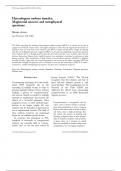The Linacre Quarterly 81 (1) 2014, 38–46
Heterologous embryo transfer:
Magisterial answers and metaphysical
questions
MICHEL ACCAD
San Francisco, CA, USA
The debate regarding the morality of heterologous embryo transfer (HET) as a solution for the fate of
cryopreserved embryos remains active. This paper endeavors to show that the magisterial instructions on
bioethical issues can only lead to the conclusion that HET is always morally illicit. I begin by showing
that the text of Dignitas personae recognizes HET as a procedure accomplishing a procreative function,
and I indicate that it is through gestation that this procreative function occurs. I further show that the
previous Instruction, Donum vitae, implicitly points to an ontological or spiritual consideration at play
during gestation. This consideration is likely related to the procreative function identified in Dignitas
personae. Finally, I place these two textual arguments in the context of the debate concerning HET and
conclude that metaphysical questions must be clarified in order for the immorality of HET to be under-
stood from a suitable anthropological perspective and gain more widespread acceptance.
Keywords: Heterologous embryo transfer, Bioethics, Gestation, Procreation, Dignitas personae,
Donum vitae
INTRODUCTION Jerome Lejeune (1992).1 The Church
recognizes that the situation and fate of
Contemporary techniques of in vitro fertili- these left-over embryos present a vital
zation (IVF) frequently rely on the moral problem. The Congregation for the
harvesting of multiple oocytes in order to Doctrine of the Faith (CDF) has
generate multiple embryos. Excess embryos addressed the ethical issues surrounding
undergo a process of “cryopreservation” cryopreservation in its 2008 Instruction
and may be thawed as needed to multiply Dignitas personae:
attempts at implantation and increase the
chance of a successful pregnancy. Once
pregnancy occurs, or when artificial repro- Cryopreservation is incompatible with the
duction is no longer sought, left over respect owed to human embryos; it presup-
embryos may be discarded or destroyed for poses their production in vitro; it exposes
them to the serious risk of death or phys-
use in experimental research. The bulk of
ical harm, since a high percentage does
these embryos, however, are maintained
not survive the process of freezing and
frozen for an indefinite period of time. thawing; it deprives them at least tempor-
In countries that participate in IVF, arily of maternal reception and gestation;
hundreds of thousands of cryopreserved it places them in a situation in which
embryos are currently held in “concen- they are susceptible to further offense and
tration cans” to use the term coined by manipulation. (n. 18, original emphasis)
© Catholic Medical Association 2014 DOI 10.1179/2050854913Y.0000000016
, Accad – Heterologous embryo transfer 39
To address this grave injustice, lay All things considered, it needs to be
organizations have promoted the use of recognized that the thousands of aban-
heterologous embryo transfer (HET), the doned embryos represent a situation of
procedure by which an embryo is thawed, injustice which in fact cannot be resolved.
re-hydrated, and placed into the womb of Therefore John Paul II made an “appeal
to the conscience of the world’s scientific
a woman who has volunteered to carry the
authorities and in particular to doctors,
pregnancy until birth, at which point the that the production of human embryos be
child may be kept by the gestational halted, taking into account that there
mother or given for adoption to other seems to be no morally licit solution
parents. According to an agency dedicated regarding the human destiny of the thou-
to the promotion of HET for the adop- sands and thousands of ‘frozen’ embryos
tion of embryos, about 3,000 children which are and remain the subjects of
have been born through this process in the essential rights and should therefore be
United States, and the rate of such births protected by law as human persons. (n.
appears to be increasing.2 19, original emphases)
The use of HET to care for cryopre-
served embryos abandoned by their While opponents of HET find support
genetic parents has been a subject of con- for their position in this passage, many
troversy among Catholic ethicists.3 commentators on the subject—including
Opponents claim that the procedure is the US Conference of Catholic Bishops
intrinsically immoral while supporters (2008)—hold that the document comes
propose that it is licit, at least under short of issuing an outright condemnation
certain conditions. In Dignitas personae, of the practice of HET in all cases, thus
the CDF has ruled against the practice of leaving the possibility of “prenatal adop-
HET as a remedy for infertility and has tion” open to further discussion. Some
issued a warning against HET when done proponents of HET argue that precisely
for the purpose of “prenatal adoption”: because Dignitas personae does not expli-
citly advocate against HET, one can
assume that the Magisterium has taken
The proposal that these embryos could be the position that the procedure is not
put at the disposal of infertile couples as a
intrinsically immoral (see, e.g., Napier
treatment for infertility is not ethically
acceptable for the same reasons which
2009; Furton 2010).
make artificial heterologous procreation This essay will endeavor to show that
illicit as well as any form of surrogate the two magisterial Instructions on
motherhood; this practice would also lead bioethical matters so far issued by the
to other problems of a medical, psycho- Vatican can only lead to the conclusion
logical and legal nature. that HET is always morally illicit. I will
first demonstrate that Dignitas personae
recognizes HET as a procedure accom-
It has also been proposed, solely in order plishing a procreative function, and I will
to allow human beings to be born who
indicate that it is through gestation that
are otherwise condemned to destruction,
that there could be a form of “prenatal
this procreative function takes place. I will
adoption.” This proposal, praiseworthy then show that the previous Instruction on
with regard to the intention of respecting bioethics, Donum vitae, implicitly points
and defending human life, presents to a significant ontological or spiritual
however various problems not dissimilar consideration at play during gestation.
to those mentioned above. This consideration, I will argue, is related





